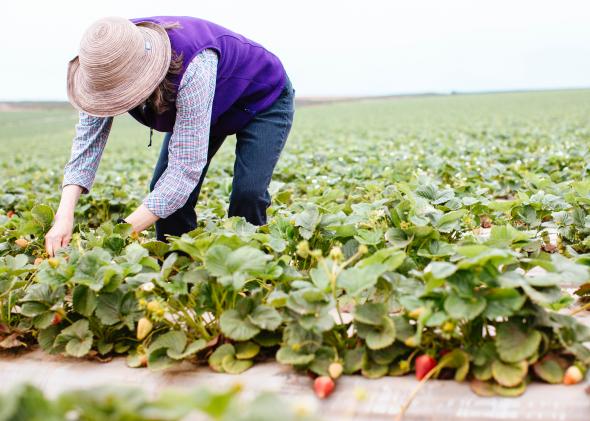
Lessons From the Fields
Pioneering research connects the dots between health and exposure to agricultural chemicals.
California’s 90-mile-long Salinas Valley, with its mild climate and rich soil, is known for abundant agriculture. Often called the “salad bowl of the world,” this fertile valley two hours south of the San Francisco Bay Area produces 70 percent of the nation’s lettuce, along with bountiful strawberries, broccoli and other cool-weather crops. But pioneering research from University of California at Berkeley, in partnership with the community in Salinas, has revealed some dire consequences from the use of chemical pesticides in the region.
At the Source: Studying Pregnant Women
Researchers connected with the community to complete the comprehensive study, and they're staying connected to help find solutions.
The study began in 1999 when UC Berkeley scientist Dr. Brenda Eskenazi and her team enrolled more than 600 pregnant women to assess their environmental exposure to pesticides through blood and urine samples. They also planned to follow the women’s children as they grew, assessing health, learning and development.
Known as CHAMACOS, an acronym for the Center for the Health Assessment of Mothers and Children of Salinas, the study is a prospective birth cohort study. By measuring the pregnant mother’s exposure, researchers track the fetus' exposure, too.

“You have real-time measurements of environmental exposures, something that had bedeviled researchers for years,” said Dr. Philip Landrigan, Dean of Global Health at Mount Sinai and one of the nation’s leading experts on environmental health and children. “In the past, you’d see children with cancer or other health issues and ask mothers what they had been exposed to in pregnancy. Parents wouldn’t know, they wouldn’t remember.”
Nearly 16 years into the study, Eskenazi and her team have published more than 100 journal articles. The implications are profound — not just for Salinas, but for communities across the country.
Pesticides Linked to Slew of Problems
The results link prenatal exposure to organophosphate pesticides, a major class of pesticides used in agriculture, with lowered IQ and attention problems in the children when they reach school age, Eskenazi said. Women living near areas where the agricultural fumigant methyl bromide was applied also had smaller birth weight babies, according to the study.
The findings show that the timing of exposure — as well as level — matters.
“Even relatively low levels of pre-natal exposure to organophosphate pesticides had marked impacts on both IQ and learning,” said Kristin Schaffer, Policy Director at Pesticide Action Network and co-author of A Generation in Jeopardy.
These findings have sparked new awareness about chemical impacts across the Salinas Valley. Norm Groot, the Executive Director of the Monterey County Farm Bureau and a member of the CHAMACOS Advisory Board, said “This research has made all the stakeholders aware of the things that impact local health issues and has caused change in the community. It’s brought awareness of patterns that before we thought were safe and now we realize may need modifications and improvements.”
Getting the Community Involved
When CHAMACOS launched it was at the forefront of a wave of new research that would connect the dots between environmental exposures and children’s health. The passage of the Food Quality Project Act in 1996 brought money to the National Institute of Environmental Health Sciences (NIEHS) and the Environmental Protection Agency and allowed them to explore these connections. Both Eskenazi and her doctoral student Asa Bradman knew they wanted to investigate agricultural chemicals: California is an agricultural state, and more than 200 million pounds of active ingredient pesticides were being sprayed in the state at the time. The research design — extending the study's scope and bringing stakeholders together — made their study unique.
“We have learned the importance of understanding all aspects of our children’s life and the adversities they face when we study their health,” Eskenazi said. “You cannot just consider the chemicals that they are being exposed to but the entirety of factors that influence their health and wellbeing. We have tried to do that in CHAMACOS.”
“It was the connections to Salinas that really developed the project, including support from a broad spectrum of the community,” added Bradman, now associate director for exposure assessment at the Center for Environmental and Research Health where the CHAMACOS study is based. The CHAMACOS Community Advisory Board includes growers, the Agricultural Commissioner, farmworker representatives, public health officers, and advocates for farmworkers and their children. Even the name of the study shows how researchers took care to design research that would connect with the community: CHAMACOS means “little kids” in Mexican Spanish, the dominant language among farmworkers in the region.
The study “is an excellent example of how researchers should engage the community being studied,” said Dr. Edward Moreno, an advisory board member as well as the health officer and director of public health for Monterey County. “It’s a model that investigators should consider as they create study designs looking at investigating other populations across the states.”
From Research to Real-World Solutions
Reseachers' commitment to the community has allowed them to successfully track hundreds of people for more than a decade.
“Having a committee with people from the community, having feedback and dialogue with the investigators … built trust between the investigators and the people being studied,” said Moreno, who also is an associate professor of pediatrics at UC San Francisco. “That trust has led to a willingness for the population to stay part of the cohort and has made people open and truthful about the data.”
CHAMACOS’s field coordinator, Kimberly Parra, sees this every day as children, and their families, stream into and out of the field office. Drawn to the project because she grew up nearby and witnessed first-hand the hard work of the farmworkers in fields, she’s a key force in keeping the research connected to the community — even as some cohort members move. Families have moved to Arizona and some back across the border to Mexico and Central America.
“It takes a village to do a study this complicated," Eskenazi said. "We have had generations of students at all levels helping in Berkeley and in the field and dedicated staff some working for the entirety of the study who know each child personally.”
The bustling CHAMACOS field office is often abuzz with the 13- and 14-year-olds in the cohort coming in for annual checkups and tests. The children, now teenagers, bring new energy, questions, and ideas to the study, Parra said. They recently completed a project with teens in the community identifying ways to limit their chemical exposure. Said Parra: “We’ve become a part of their lives.”
